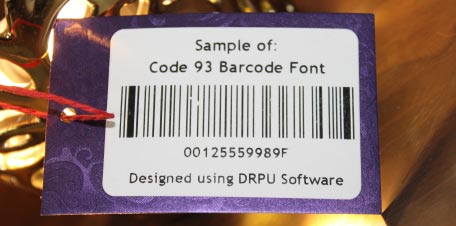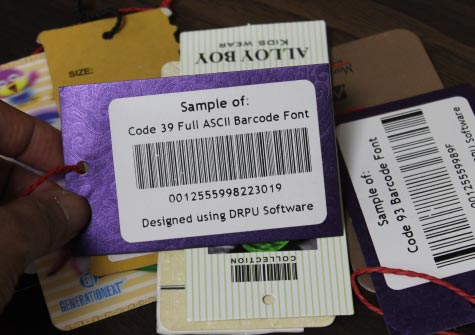Information about CODE-93 Barcode
A Code 93 barcode is a linear, high-density barcode that is similar to the more commonly known Code 39 barcode. It was developed by Intermec Corporation in 1982 as an improvement over the Code 39 barcode. It is capable of encoding more characters in a smaller space than the Code 39 barcode and has a higher level of error correction.
The Code 93 barcode is a variable length, continuous barcode that can encode up to 47 characters in a single symbol. It uses a combination of bars and spaces to represent alphanumeric characters and symbols. Each character is encoded using nine modules, which consist of a combination of wide and narrow bars and spaces.

Introduction of Code-93 Barcode
One of the primary advantages of the Code 93 barcode is its high level of data density. Because it uses nine modules to encode each character, it is capable of encoding more characters per unit of space than the Code 39 barcode. This makes it well-suited for applications where space is limited, such as on small products or in applications where large amounts of data need to be encoded in a small space.
The Code 93 barcode also includes two check digits that are used to ensure the accuracy of the data encoded in the barcode. The first check digit is calculated using a modulo-47 algorithm, while the second check digit is calculated using a modulo-43 algorithm. These check digits are used to detect and correct errors that may occur during barcode scanning.
In addition to its high data density and error correction capabilities, the Code 93 barcode also includes several other features that make it well-suited for a wide range of applications. These include:
-
Optional start/stop characters:
The Code 93 barcode includes optional start and stop characters that can be used to improve barcode readability.
-
Full ASCII support:
The Code 93 barcode supports the full ASCII character set, allowing it to encode a wide range of alphanumeric characters and symbols.
-
Multiple barcode formats:
The Code 93 barcode can be printed in multiple formats, including horizontal, vertical, and diagonal, making it well-suited for a wide range of applications.
-
Wide barcode bars:
The Code 93 barcode uses wide bars that are 50% wider than those used in the Code 39 barcode, making it easier to scan in low-light conditions or when the barcode is printed at a small size.
Some common applications of the Code 93 barcode include inventory management, shipping and receiving, and asset tracking. It is also used in the healthcare industry to encode patient information and medical data.
In conclusion, the Code 93 barcode is a high-density barcode that is capable of encoding more data in a smaller space than the Code 39 barcode. Its high level of error correction, full ASCII support, and multiple barcode formats make it well-suited for a wide range of applications, including inventory management, shipping and receiving, and asset tracking.
Applications of Code-93 Barcode
The Code 93 barcode is a high-density barcode that is capable of encoding more data in a smaller space than the Code 39 barcode. Its high level of error correction, full ASCII support, and multiple barcode formats make it well-suited for a wide range of applications, including inventory management, shipping and receiving, and asset tracking. In this section, we will explore some of the most common applications of the Code 93 barcode.
-
Inventory Management:
The Code 93 barcode is commonly used in inventory management applications. It allows businesses to track their inventory levels in real-time, which can help them optimize their supply chain and improve their overall efficiency. By using a barcode scanner to read the Code 93 barcode on each item in their inventory, businesses can quickly and accurately update their inventory database, making it easier to track which items are in stock and which need to be reordered.
-
Shipping and Receiving:
The Code 93 barcode is also commonly used in shipping and receiving applications. By encoding shipping information in a Code 93 barcode, businesses can ensure that their shipments are accurately tracked and delivered to the correct destination. This can help to reduce shipping errors and improve customer satisfaction. Additionally, by using a barcode scanner to read the Code 93 barcode on each package, businesses can quickly update their shipping database, making it easier to track the status of each shipment.
-
Asset Tracking:
The Code 93 barcode is often used in asset tracking applications. By encoding asset information in a Code 93 barcode, businesses can track the location and status of their assets in real-time. This can help to prevent loss or theft of assets and ensure that they are being used efficiently. For example, businesses can use the Code 93 barcode to track the location of their equipment, such as laptops or machinery, to ensure that they are being used in the correct location and are not being used by unauthorized personnel.
-
Healthcare:
The Code 93 barcode is also used in healthcare applications. By encoding patient information in a Code 93 barcode, healthcare providers can quickly access important medical information, such as patient medical history or medication allergies. This can help to improve patient safety and ensure that healthcare providers have all of the information they need to provide effective care. Additionally, the Code 93 barcode can be used to track medical equipment and supplies, making it easier to manage inventory and ensure that equipment is being used efficiently.
-
Manufacturing:
The Code 93 barcode is commonly used in manufacturing applications. By encoding product information in a Code 93 barcode, manufacturers can track the production of their products in real-time, from raw materials to finished products. This can help to improve quality control and ensure that products are being produced efficiently. Additionally, the Code 93 barcode can be used to track the location of equipment and supplies in the manufacturing facility, making it easier to manage inventory and ensure that equipment is being used efficiently.
-
Retail:
The Code 93 barcode is also used in retail applications. By encoding product information in a Code 93 barcode, retailers can track the sales of their products in real-time, making it easier to manage inventory levels and ensure that products are being restocked in a timely manner. Additionally, the Code 93 barcode can be used to track the location of products in the retail store, making it easier to manage inventory and ensure that products are being displayed in an effective manner.
In conclusion, the Code 93 barcode is a versatile and widely used barcode that has many applications across a wide range of industries. Its high level of data density, error correction capabilities, and full ASCII support make it well-suited for a variety of applications, including inventory management, shipping and receiving, asset tracking, healthcare, manufacturing, and retail.
Download and Install CODE-93 Barcode Software
Difference of Code-93 Barcode from Other Barcodes
The Code 93 barcode is a type of barcode that is often used in a variety of applications, including inventory management, asset tracking, and shipping and receiving. While there are many different types of barcodes, each with their own strengths and weaknesses, the Code 93 barcode is distinguished by several unique features that set it apart from other barcode types. In this section, we will explore some of the key differences between the Code 93 barcode and other barcode types.

-
High Data Density
One of the key advantages of the Code 93 barcode is its high data density. The Code 93 barcode is capable of encoding more data in a smaller space than many other barcode types, making it well-suited for applications where space is limited. This high data density is achieved through the use of a variable-length code, which allows the barcode to encode a wide range of characters using fewer bars and spaces than other barcode types.
-
Full ASCII Support
Another key advantage of the Code 93 barcode is its full ASCII support. Unlike some other barcode types, which are limited to encoding only numeric or alphanumeric data, the Code 93 barcode is capable of encoding a full range of ASCII characters, including control codes and special characters. This makes the Code 93 barcode well-suited for applications where a wide range of data must be encoded, such as in inventory management or asset tracking.
-
Multiple Barcode Formats
The Code 93 barcode is also notable for its ability to support multiple barcode formats. This allows the barcode to be customized to suit a wide range of applications, with different formats optimized for different types of data. For example, the horizontal format is well-suited for encoding alphanumeric data, while the stacked format is better suited for encoding numeric data.
-
High Level of Error Correction
Another advantage of the Code 93 barcode is its high level of error correction. The Code 93 barcode is designed to be resistant to errors caused by dirt, smudging, or other forms of damage to the barcode. This is achieved through the use of a checksum, which allows the barcode reader to detect and correct errors in the barcode data. Additionally, the Code 93 barcode uses a self-checking mechanism, which helps to prevent errors caused by misreading or misinterpreting the barcode data.
-
Limited Usage
One key difference between the Code 93 barcode and other barcode types is its limited usage. While the Code 93 barcode is a versatile and widely used barcode, it is not as commonly used as some other barcode types, such as the Code 39 or UPC barcode. This can make it more difficult to find barcode scanners or software that support the Code 93 barcode, particularly in smaller or less-developed markets.
In conclusion, the Code 93 barcode is a versatile and widely used barcode that is distinguished by several unique features that set it apart from other barcode types. Its high data density, full ASCII support, multiple barcode formats, high level of error correction, and versatility make it well-suited for a wide range of applications, including inventory management, asset tracking, and shipping and receiving. However, its limited usage can make it more difficult to find barcode scanners or software that support the Code 93 barcode, particularly in smaller or less-developed markets.
